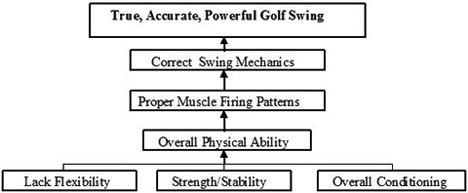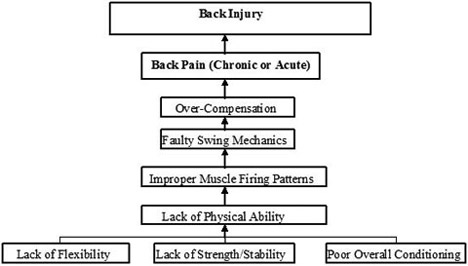How to protect your back and improve your game
Back pain is a common problem for most golfers. Even professional players such as Jack Nicklaus and Fred Couples have had to contend with back pain over the course of their careers. Now, if these professional players are having pain, it only stands to reason that many amateur and/or recreational golfers experience the same problem. The main reason for this is that during a full golf swing, the muscles of the lumbar spine reach approximately 90 percent of peak muscle activity. This equates to greater spinal loading and creates the potential for the occurrence of back pain or injury.
As Diagram A below shows, there is a progression for good golf swings to occur, and there are three characteristics of physical ability that are the foundation for that process: flexibility, strength/stability and overall conditioning.
Here's how the foundational physical abilities relate to the development of back pain or injury:
Flexibility - If you do not have adequate flexibility, your ability to build strength and stability in desired areas, as well as your ability to produce proper muscle-firing patterns, will be compromised.
Strength/Stability - Without strength in the appropriate areas, you will lack the ability to distribute the forces being produced across the entire spectrum of the working musculature. Lack of stability will affect your posture, which, in turn, will affect your swing.
Overall Conditioning - Although golf is not considered a very physically taxing sport, the high amount of force produced during each swing of the golf club and the many hours spent on the course combine to generate high levels of fatigue. Fatigue is generally a precursor to injury. Well-conditioned athletes experience less fatigue and fewer injuries.
The point is that a deficiency in any or all of the above foundational abilities can lead to problems with your swing. And problems with your swing will likely lead to over-compensation/over-swinging, which, along with the already high amounts of force being produced, can lead to back pain or injury.
The best way for you to identify and correct any deficiencies is to use an integrated approach in which you solicit the advice of both your swing coach and your golf fitness professional to develop an effective program for your specific needs. By improving your foundational abilities, not only will you be taking preventive measures against back pain/injury, you will also be moving toward a truer, more accurate and more powerful swing and lower scores!
Bonus Tip: This is a tip from my colleague, Bill Hartman. If you have already started a golf fitness program, try performing 80 percent to 90 percent of your exercises in the standing position during your training sessions. This will dramatically improve golf-specific strength.
NOTE: Before beginning any exercise or dietary program, consult with your physician to ensure that you are in proper health and that any exercise or dietary program you undertake will not put you at risk.


Troy M. Anderson, B.A., PES, CPT, IACPFT, is the owner of Integrated Evolution, LLC, in Tempe, Ariz. The top goal of Integrated Evolution is to provide individuals with solutions to their performance enhancement needs. For more golf fitness tips, visit integratedevolution.org.
 By
By